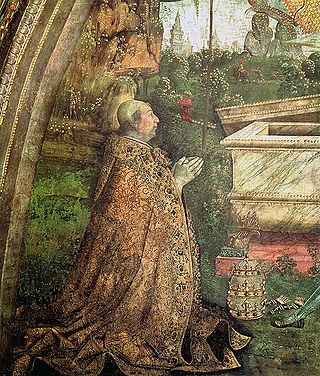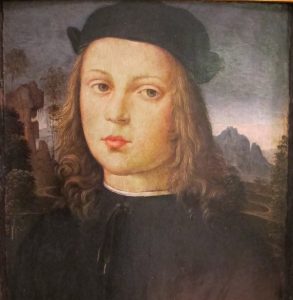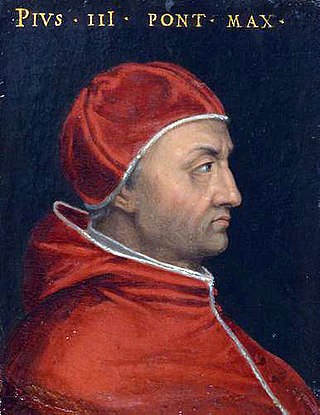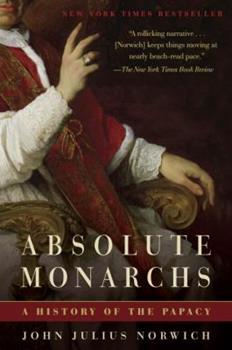
Cesare Borgia was an Italian cardinal and condottiero, an illegitimate son of Pope Alexander VI and member of the Valencian (Spanish-Aragonese) House of Borgia. His fight for power was a major inspiration for The Prince by Niccolò Machiavelli.

Lucrezia Borgia was an Italian noblewoman of the House of Borgia who was the illegitimate daughter of Pope Alexander VI and Vannozza dei Cattanei. She reigned as the governor of Spoleto, a position usually held by cardinals, in her own right.

Pope Alexander VI (epithet: Valentinus was head of the Catholic Church and ruler of the Papal States from 11 August 1492 until his death in 1503. Born into the prominent Borgia family in Xàtiva in the Kingdom of Valencia under the Crown of Aragon, Rodrigo studied law at the University of Bologna. He was ordained deacon and made a cardinal in 1456 after the election of his uncle as Pope Callixtus III, and a year later he became vice-chancellor of the Catholic Church. He proceeded to serve in the Curia under the next four popes, acquiring significant influence and wealth in the process. In 1492, Rodrigo was elected pope, taking the name Alexander VI.

Pope Callixtus III, born Alfonso de Borgia, was head of the Catholic Church and ruler of the Papal States from 8 April 1455 to his death, in August 1458.

Pope Julius II was head of the Catholic Church and ruler of the Papal States from 1503 to his death, in February 1513. Nicknamed the Warrior Pope, Battle Pope or the Fearsome Pope, he chose his papal name not in honour of Pope Julius I but in emulation of Julius Caesar. One of the most powerful and influential popes, Julius II was a central figure of the High Renaissance and left a significant cultural and political legacy. As a result of his policies during the Italian Wars, the Papal States increased their power and centralization, and the office of the papacy continued to be crucial, diplomatically and politically, during the entirety of the 16th century in Italy and Europe.

Ferdinand Gregorovius was a German historian who specialized in the medieval history of Rome.

The House of Borgia was a Spanish noble family, which rose to prominence during the Italian Renaissance. They were from Xàtiva, Kingdom of Valencia, the surname being a toponymic from the town of Borja, then in the Crown of Aragon, in Spain.
The Banquet of Chestnuts was a supper purportedly held at the Papal Palace in Rome and hosted by former Cardinal Cesare Borgia, son of Pope Alexander VI, on 31 October 1501.
Johann Burchard, also spelled Johannes Burchart or Burkhart (c.1450–1506) was an Alsatian-born priest and chronicler during the Italian Renaissance. He spent his entire career at the papal Courts of Sixtus IV, Innocent VIII, Alexander VI, Pius III, and Julius II, serving as papal Master of Ceremonies, a position from which he was able to observe most of the important events of the period.

The Borgia Apartments are a suite of rooms in the Apostolic Palace in the Vatican, adapted for personal use by Pope Alexander VI. In the late 15th century, he commissioned the Italian painter Bernardino di Betto (Pinturicchio) and his studio to decorate them with frescoes.
Duke of Camerino is a title of nobility, originally in Papal peerage. It was created on 1503 by Apostolic authority of Pope Alexander VI and cardinal council over the ancient Marquissate of Camerino, which was part of the Dukedom of Spoleto.

The Borgias is a British television drama serial produced by the BBC in 1981, in association with the Second Network of the Italian broadcaster RAI. The series, produced by Mark Shivas, was set in Italy during the late 15th and early 16th centuries and told the story of Rodrigo Borgia – the future Pope Alexander VI – and his family, including his son Cesare and daughter Lucrezia.

Giulia Farnese was an Italian noblewoman, a mistress to Pope Alexander VI, and the sister of Pope Paul III. Known as Giulia la bella, she was a member of the noble Farnese family, who were prominent leaders in the Italian regions of Parma and Piacenza. After marrying into the noble Orsini family in the Papal States, Farnese soon acquainted herself with, and initiated an affair with, the Spanish Cardinal Rodrigo de Borja. When the cardinal was elected Pope, Farnese continued the increasingly advantageous liaison, which enabled her to have her brother Alessandro made a cardinal, until losing Alexander's favor at the turn of the century.

The Renaissance Papacy was a period of papal history between the Western Schism and the Reformation. From the election of Pope Martin V of the Council of Constance in 1417 to the Reformation in the 16th century, Western Christianity was largely free from schism as well as significant disputed papal claimants. There were many important divisions over the direction of the religion, but these were resolved through the then-settled procedures of the papal conclave.

Alfonso of Aragon, Duke of Bisceglie and Prince of Salerno of the House of Trastámara, was the illegitimate son of Alfonso II King of Naples and his mistress Trogia Gazzella. His father, cousin of King Ferdinand II of Aragon, abdicated in favour of his legitimate son Ferdinand II of Naples.

Gaspar de Borja y Velasco was a Spanish cardinal, ecclesiastic and politician. He belonged to the house of Borgia and served as Primate of Spain, Archbishop of Seville, Archbishop of Toledo and viceroy of Naples. He was the great-great-great-great-grandson of Pope Alexander VI.

The September 1503 papal conclave elected Pope Pius III to succeed Pope Alexander VI. Due to the Italian Wars, the College of Cardinals was surrounded by three potentially hostile armies, loyal to Louis XII of France, Ferdinand II of Aragon, and Cesare Borgia.

The Borgias is a historical drama television series created by Neil Jordan; it debuted in 2011 and was canceled in 2013.

The Route of the Borgias is a cultural route, that includes sites associated with the Borja or Borgia, located in their native Valencian Community, Spain. The marketing of the route was inaugurated in 2007.

Absolute Monarchs: A History of the Papacy is a 2011 book by the English popular historian John Julius Norwich published in the United States by Random House. It was published slightly earlier in the UK by Chatto & Windus under the title Popes: A History. It was introduced after Norwich had progressively built his reputation with more than twenty previous published titles and received significant notice in the press.

















